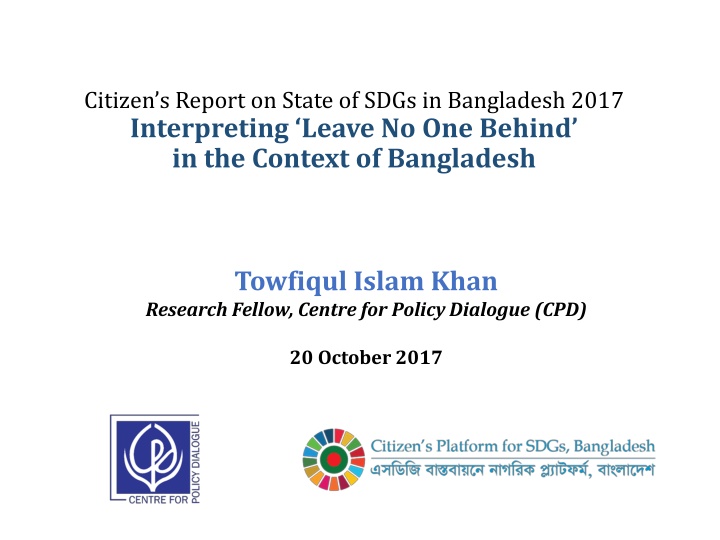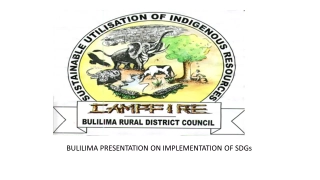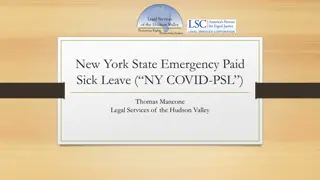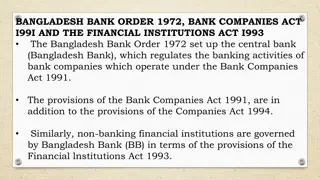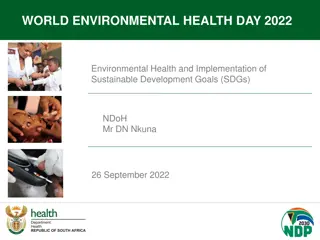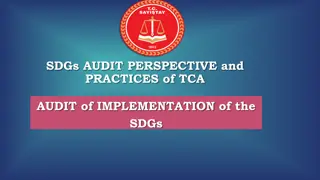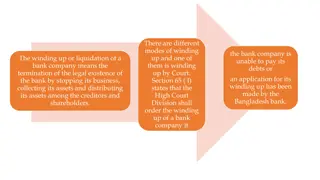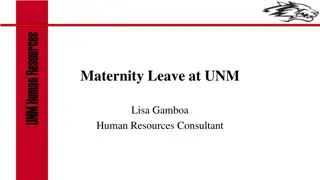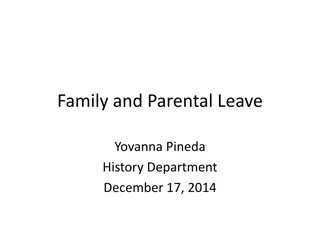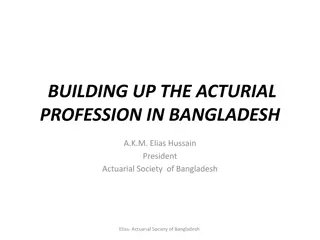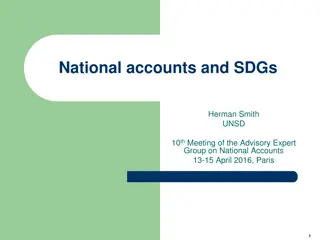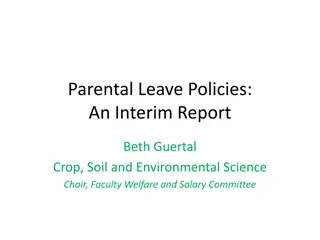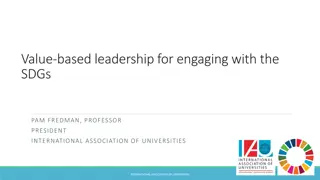State of SDGs in Bangladesh: Leave No One Behind
This report presents an analysis of the state of Sustainable Development Goals (SDGs) in Bangladesh, emphasizing the imperative of 'Leave No One Behind'. Authored by Towfiqul Islam Khan of the Centre for Policy Dialogue (CPD), the report delves into the progress, challenges, and recommendations for achieving the SDGs in the context of Bangladesh's development landscape. It offers valuable insights and policy implications to ensure inclusivity and equitable progress towards sustainable development.
Download Presentation

Please find below an Image/Link to download the presentation.
The content on the website is provided AS IS for your information and personal use only. It may not be sold, licensed, or shared on other websites without obtaining consent from the author.If you encounter any issues during the download, it is possible that the publisher has removed the file from their server.
You are allowed to download the files provided on this website for personal or commercial use, subject to the condition that they are used lawfully. All files are the property of their respective owners.
The content on the website is provided AS IS for your information and personal use only. It may not be sold, licensed, or shared on other websites without obtaining consent from the author.
E N D
Presentation Transcript
Citizens Report on State of SDGs in Bangladesh 2017 Interpreting Leave No One Behind in the Context of Bangladesh Towfiqul Islam Khan Research Fellow, Centre for Policy Dialogue (CPD) 20 October 2017
Outline 1. Background 2. Citizen s Platform The Initiative 3. Understanding LNOB based on 2030 Agenda 4. FGDs with Professionals Initial Results 5. Conceptualizing Vulnerability Approaches and Categories 6. Key Findings 2
1. Background Transforming Our World: the 2030 Agenda for Sustainable Development 17 Goals with 169 targets between them, agreed upon on Sept 25, 2015 Expanded scope of goals and sectors with MoIs Defining characteristics: universal, inclusive, transformative, and integrated Multi-stakeholder approach to implementation Country-led and country-driven approach Data revolution need for disaggregated, real- time, accessible, and quality data About the SDGs Leave No One Behind (LNOB) Guiding Principle 3
1. Background (Contd.) Country-Level Implementation: Bangladesh Integration into the 7th Five Year Plan (7FYP) Thematically aligned Not aligned Aligned Partially aligned N/A 3 Goals 17 Goals 14 goals O O O (SDG 1, 16, 17) 169 Targets O 56 37 65 11 Related documents: Integration of Sustainable Development Goals (SDGs) into the 7th Five Year Plan Data Gap Analysis for Sustainable Development Goals (SDGs); Mapping of Ministries by Targets in the implementation of SDGs aligning with 7FYP (2016-20) Strengthening Finance for the 7FYP and SDGs in Bangladesh (forthcoming) Major implementation challenges: Benchmarking, target setting, policy coherence, institutional coordination, data availability, capacity development, resource availability, follow-up and review Voluntary National Review (VNR) on behalf of Bangladesh (along with 43 other states) to be submitted in HLPF (July 2017) based on indicators for which data are available (i.e. 70 indicators) 4
2. Citizens Platform The Initiative Being committed to implementation of Agenda 2030 at the national level, a group of individuals in Bangladesh took an initiative to set up the Citizen s Platform for SDGs, Bangladesh with the objective to contribute to the delivery of the SDGs and enhance transparency and accountability in the process at the country level Launched in June 2016; 13 Advisors; 8 Core Group Members; about 50 Partners; and CPD is the Secretariat. Activities of the Platform Knowledge Generation Awareness Building Policy Influencing Capacity Development Network Strengthening 5
2. Citizens Platform The Initiative (Contd.) Citizen s Report on State of SDGs in Bangladesh 2017 The Bangladesh Context : Leave No One Behind Follow-up and review of the 2030 Agenda will be an open, inclusive, participatory and transparent framework for all people, so it can support reporting by all relevant stakeholders. As a part of its work programme, the Platform is going to prepare a flagship report to support the country level review (for HLFP to be held in July 2017) Why? Providing voice to the marginalised based on knowledge and evidence Contextualising this proposition raises few questions on- Who are these people? How do we identify them? What could be the new public policy interventions? What are their needs? 6
3. Understanding Leave No One Behind based on 2030 Agenda As we embark on this collective journey, we pledge that no one will be left behind. - Preamble, in reference to how all countries and stakeholders will need to work together to achieve the objective of the Agenda As we embark on this great collective journey, we pledge that no one will be left behind. Declaration, Intro: Paragraph 4, in talking about the fundamentality of human dignity To promote physical and mental health and well being and to extend life expectancy for all, we must achieve universal health coverage and access to quality health care. No one must be left behind. - The new Agenda, Paragraph 26 Indicators are being developed to assist this work. Quality, accessible, timely and reliable disaggregated data will be needed to help with the measurement of progress and to ensure that no one is left behind. - Follow-up and review; Paragraph 48 We commit to engaging in systematic follow-up and review of the implementation of this Agenda over the next 15 years. A robust, voluntary, effective, participatory, transparent and integrated follow-up and review framework will make a vital contribution to implementation and will help countries to maximize and track progress in implementing this Agenda in order to ensure that no one is left behind. - Follow-up and review; Paragraph 72 7
3. Understanding Leave No One Behind based on 2030 Agenda (Contd.) As we embark on this great collective journey, we pledge that no one will be left behind. Recognizing that the dignity of the human person is fundamental, we wish to see the Goals and targets met for all nations and peoples and for all segments of society. And we will endeavor to reach the furthest behind first. - Declaration, Paragraph 4 They will be people-centred, gender-sensitive, respect human rights and have a particular focus on the poorest, most vulnerable and those furthest behind. - Follow-up and review, Paragraph 74 (e), in reference to the principles that will guide the Follow-Up and Review process 8
3. Understanding Leave No One Behind based on 2030 Agenda (Contd.) [N]o goal should be met unless it is met for everyone (ODI, 2015) Basic Framing As a tool for GREATER INCLUSION and GOAL-BASED SPECIFICITY Health: MDG to SDG --> Expanded coverage of diseases targeted for eradication (Fitzpatrick and Engels, 2016) Sector-Based Framing SDGs: Inter-linkages and Interoperability Social Protection Target 1.3 (Implement social protection systems) Goals 3, 5 and 10 Health, Education, Gender Equality, Decent Work (Targets 3.8, 5.4 and 8.5) Goal-Based Framing (UNDP, 2016) Global-Level Framing Not only Leave No [Person] Behind but also Leave No Country Behind (Bhattacharya, 2015; Lynch, Takeuchi, Samman and Sarwar, 2016) 9
3. Understanding Leave No One Behind based on 2030 Agenda (Contd.) EASY TARGETS -> Nature of approaches could lead to targeting low-hanging fruit rather than those most in need. (ODI, 2015) CONFLATION -> Misinterpretation of causal mechanisms leading to exclusion. For instance: housing exclusion usually fails to take into account that slum-dwellers may be forced residents due to costs and social exclusion rather than income inequality alone. (Gabay and Ilcan, 2017) Policy Issues MANDATORY INCLUSION -> [A]n explicit project of compulsion that everyone ought to be a part even when it is not [sustainable]. (Gabay and Ilcan, 2017) POLICY NOT PRACTICE -> Despite the World Bank claiming disability inclusiveness as central to its work, its various projects show that policy is not translating into practice. (Karr, Sims, Brusegaard and Coates, 2016) INTERSECTIONAL INEQUALITIES -> Policies do not take into consideration the impact of intersecting inequalities and that compounding of these issues leads to double discrimination. (Mangubhai and Capraro, 2015) 10
4. FGDs with Professionals Initial Results Key Observations Contextualising vulnerability remains a challenge coexistence of multiple vulnerabilities is quite common. Sources of vulnerability - policy induced or structural weaknesses or due to shocks . Interlinkages among vulnerabilities persist as it is also pertinent to identify the primary source of vulnerability for applying priority interventions . Policy interventions may differ from one vulnerable group to another. Support policies are necessary, but it is more important to make the mainstream policies and institutions sensitive to the needs of the vulnerable. Need to move from input, output and process indicators to outcome assessment. Policies work best and results are more sustainable when short term interventions are part of well-thought out medium to long term strategies. 11
5. Conceptualizing Vulnerability Approaches and Categories Vulnerable Furthest Behind Marginalised Leave No One Behind Deprived Discriminated Excluded 12
5. Conceptualizing Vulnerability Approaches and Categories (Contd.) Vulnerability Vulnerability is not the same as poverty. It means not lack or want, but defencelessness, insecurity and exposure to risks, shocks and stress (Chambers 1989) Marginalised When others treat (a person, group or concept) as insignificant or peripheral (Oxford Dictionary: Hobson 2004) Dictionary: Hobson 2004) Discriminated To make an unjust or prejudicial distinction in the treatment of different categories of people or things, especially on the grounds of race, sex or age (Oxford Excluded To deny (someone) access to or bar (someone) from a place, group or privilege (Oxford Dictionary: Stevenson 2010) Deprived Furthest Behind Deprivation may be defined as a state of observable and demonstrable disadvantage relative to the local community, wider society or nation to which an individual, family or group belongs (Townsend 1987) The furthest behind are invisible, do not exist, are often depressed, not respected and not treated as part of society. (Svensson 2016) 13
5. Conceptualizing Vulnerability Approaches and Categories (Contd.) Why should we assess Vulnerability? An Operational Definition: Vulnerability assesses an individual or group s susceptibility to risks in terms of their exposure and adaptive capacity. The state of vulnerability determines if they are pressured into becoming marginalised, discriminated or excluded, eventually becoming deprived or left furthest behind. (Adapted from Cardona et al. 2012, Chambers 1989, Bachofen and Cameron 2001) What are the roots of Vulnerability? 1. Potential Risks Structural Reasons 2. Level of Exposure Policy Distortion 3. Adaptive Capacity Shocks Different types 14
Chapter 1: Conceptualizing Leave No One Behind: The Methodological Approach The leave no one behind pledge comes amidst the realisation that too many people are still poor, marginalised, excluded, disadvantaged, and at risk of violence and discrimination. They are still abashed by the enduring inequalities when it comes to accessing resources, opportunities and their rights at global, regional, national and local contexts. The idea that no goal should be met unless it is met for everyone translates to the fact that everyone is entitled to equal rights and opportunities to live a fulfilling life with dignity (ODI, 2015). The answer to the question of who is being left behind? will be different in different countries (Stuart et al, 2016) 15
Chapter 1: Conceptualizing Leave No One Behind: The Methodological Approach To be able to identify the people, groups and communities at risk of being left behind and extend SDG implementation to effectively reach them it is crucial to contextualise LNOB at the national and local levels There is a danger that, while the achievement of this ambition (to LNOB) is pivotal to the success of Agenda 2030, it will not be implemented or monitored in the same way as other aspects of the SDGs (ODI, 2016). Any approach to leave no one behind needs to map out and respond to intersecting inequalities and ensure that people with multiple disadvantages still have their human rights fulfilled and are not falling through the gaps (Bond, 2016). 16
Chapter 1: Conceptualizing Leave No One Behind: The Methodological Approach A poor rural/remote minority female child with disability may in theory be most vulnerable without adequate access to essentials like education, health, infrastructure, social security, justice and rule of law. Inter-linkages will be seen through the lens of access to basic needs and human rights. Unlike the MDGs, whose focus was rather on the former, SDGs have infused the rights based approach in its discourse. There is a challenge of prioritisation in light of the ongoing moral debate on who to reach first- the ones with maximum potential impact, the ones most easily reached, the ones making most economic sense or the ones who are left furthest behind and hardest to reach. 17
Chapter 2: Identifying vulnerability criteria and benchmarking the state of affairs 12 criteria (attributes/characteristics) i. Life Cycle (e.g. child, youth, senior citizen) ii. Civil identity (e.g. Urdu-speakers, Rohingya??) iii. Disability (e.g. physical, mental, autistic) iv. Education & skill (e.g. religious, low level) v. Gender (e.g. women, transgender) vi. Geographical Location (e.g. Char, haor, coastal, river erosion) vii. Health (e.g. HIV, Communicable diseases) viii. Income (e.g. hard-core poor, low income group without social security) ix. Occupation (e.g. hazardous work, child labour, sex-worker) x. Religion and ethnicity (e.g. Dalit, minority) xi. Sexual orientation (e.g. LGBTQ) xii. Shock-induced e.g. Climate induced, price related, health hazards. 18
Chapter 2: Identifying vulnerability criteria and benchmarking the state of affairs (Contd..) Data and Methodology Data on SDGs indicators have been collected on the vulnerable criteria identified in the Focused Group Discussion (FGD). The secondary data have been collected from different survey reports which were conducted by different public and private organizations (e.g. LFS, BDHS) and also from international sources (e.g. WDI, World Bank). Unit level data also extracted from Household Income and Expenditure Survey (HIES). Data for 75 indicators under 17 goals have been collected; of which data on disaggregated level are available for 36 indicators. 19
Chapter 2: Identifying vulnerability criteria and benchmarking the state of affairs (Contd..) Data and Methodology (Contd..) Geographical Location Rural/U rban Religion and Ethnicity Religi on ty 1 0 2 2 0 0 0 0 0 1 0 0 0 0 0 0 0 6 Civil Identit y Wealt h Status Sexual Orientati on Shock Induce d Goal/Criter ia Goal 1 Goal 2 Goal 3 Goal 4 Goal 5 Goal 6 Goal 7 Goal 8 Goal 9 Goal 10 Goal 11 Goal 12 Goal 13 Goal 14 Goal 15 Goal 16 Goal 17 Total Life Cycle Disabilit y Education & Skill Gende r Divis ion Healt h Occupatio n Ethnici 1 3 4 3 3 0 0 3 0 0 0 0 0 0 0 2 0 0 0 0 0 0 0 0 0 0 0 0 0 0 0 0 0 0 0 0 0 0 1 0 0 0 0 0 1 0 0 0 0 0 0 0 2 1 3 4 1 3 2 0 1 0 0 0 0 0 0 0 2 0 1 2 6 3 0 0 0 5 1 1 0 0 0 0 0 2 0 2 3 2 3 5 3 3 2 1 0 0 0 0 0 1 0 0 2 0 0 0 0 0 0 0 0 0 0 0 0 0 0 0 0 0 0 0 0 3 4 2 3 2 0 0 0 0 0 0 0 0 0 1 0 1 0 0 0 0 0 0 2 0 0 0 0 0 0 0 0 0 3 0 0 0 2 0 0 0 0 0 0 0 0 0 0 0 0 0 2 0 0 0 0 0 0 0 0 0 0 0 0 0 0 0 0 0 0 0 0 0 0 0 0 0 0 0 0 0 0 1 0 0 0 0 1 10 3 3 2 1 5 1 2 0 0 0 0 0 2 0 34 19 17 21 22 15 20
Chapter 2: Identifying vulnerability criteria and benchmarking the state of affairs (Contd..) Data and Methodology (Contd..) Data Analysis Indicators at national levels have been considered as benchmarks and compared to the indicators at the disaggregated levels. Constructing Vulnerability Index Using data from the Household Income and Expenditure Survey (HIES), vulnerability Index (VI) will be derived based on the Principal Component Analysis (PCA) to see which criteria are mostly related with the vulnerability. Data in categorical form are not suitable for principal component analysis. To avoid this, qualitative categorical variables should be re-coded into dichotomous variables as follows: 21
Chapter 2: Identifying vulnerability criteria and benchmarking the state of affairs (Contd..) Data and Methodology (Contd..) Criteria Age Disability Education & Skill Conditions & Scores 0-17 or 60+: 1; Otherwise: 0 Disabled: 1; Otherwise: 0 Less than secondary & not currently attending (age>5 years): 1; Otherwise: 0 Female: 1; Otherwise (Male): 0 Geographically Vulnerable Location: 1; Otherwise: 0 Gender Geographical Location Health Income Occupation Religion Shock Induced Chronically Ill or Disabled: 1; Otherwise: 0 Bottom 10%: 1; Otherwise: 0 Day laborer: 1; Otherwise: 0 Non-Muslims: 1; Otherwise: 0 Experienced a Shock (e.g. Flood, Conflict): 1; Otherwise: 0 22
Chapter 2: Identifying vulnerability criteria and benchmarking the state of affairs (Contd..) Findings In general, population of rural areas are left behind in every forms than the national counterparts. But there are few exceptions, for example, Proportion of women and girls subjected to sexual violence by persons other than an intimate partner; Unemployment rate and the inequality in total wealth and consumer durable goods. Uneducated (no education) and less-educated population are generally left behind in Bangladesh than the national counterparts except in unemployment rate is higher among the higher-educated population. unemployment rate. The 23
Chapter 2: Identifying vulnerability criteria and benchmarking the state of affairs (Contd..) Findings (Contd..) Female population are left behind in every sector in Bangladesh than the national counterparts. There are some exceptional cases where female population are away from the national level, e.g. Prevalence of stunting among children under-5 years, Frequency rates of fatal and non- fatal occupational injuries and time lost due to occupational injuries and Percentage of children who experienced any physical punishment by caregivers. Population with lowest as well as second lowest wealth quintiles are behind in all forms than the national counterparts. According to religion, Non-Muslims are left behind in all forms; though the severe poverty rate is lower and the fixed level of proficiency is higher among them. 24
Chapter 2: Identifying vulnerability criteria and benchmarking the state of affairs (Contd..) Findings (Contd..) Population who worked as Skilled Agricultural, Forestry & Fisheries workers; and Services workers are left behind in Bangladesh. There have 22 indicators for which administrative division wise data are available. The situation of Barisal division is worse than the national averages in case of 19 indicators. The situation is worse next to the Barisal division in Sylhet than the national level in respect of 15 indicators. Again the situation is worse in Rangpur division than the national averages for 13 indicators. 25
Chapter 2: Identifying vulnerability criteria and benchmarking the state of affairs (Contd..) Findings (Contd..) Inequality From the Gini coefficient it is seen that the wealth inequality is increasing in Bangladesh over the time. The inequality is higher among urban households. The wealth inequality has been decreased in rural area. Again, the income inequality has been increased over time and the increasing rate is higher in urban area. The wealth inequality is higher than the income inequality. Disabled Population All disabled population segments have lower literacy rates than that of the reference populations. The performance of disabled population by education level (Highest class passed) is worse in every segments than the reference level. 26
Chapter 2: Identifying vulnerability criteria and benchmarking the state of affairs (Contd..) Findings (Contd..) The average value of wealth owned by households with disable head is lower than the benchmarking level except in rural area. Chittagong Hill-Tracts (CHT) Literacy Rates of Household Head in the Chittagong Hill Tracts Region (CHT) is lower than the national counterparts. But the rate is higher among the rural household than the rural benchmarking level. The average value of wealth (current valuation in Taka, 2010) owned by households in CHT is much lower than the benchmarking level in every segments (National, Rural and Urban). 27
Chapter 3: Assessment of Needs The broad areas of needs initially identified Hunger and Nutrition Health and Sanitation Home and Shelter Quality Education and Skills Development Access to Safe Infrastructure: clean water, communication, electricity, fuel, ICT etc Employment and living wage Social Exclusion: Social and cultural recognition Citizen s Rights 28
Chapter 3: Assessment of Needs Some suggested solutions in the FGDs Increased political representation and participation in policy making processes. Making rights of vulnerable groups a political agenda Inclusion in the election manifesto Ensuring proper birth registration and identity cards Legislative actions protecting rights of vulnerable groups Improve collection of disaggregated data on vulnerable groups Increase in social acceptance and change in mind set through enhanced social awareness Increasing the number of Govt. schools in remote areas and isolated communities 29
Chapter 3: Assessment of Needs Some suggested solutions in the FGDs Residential hostels for students from remote geographic locations Effective training of teachers Improved infrastructure for PWD Diversification and industrialisation of agro-processing industries Vocational training for alternate employment Sustainable tourism with a focus on infrastructure and job creation Better monitoring reports on implementation of policies and enforcement of law Multi-sectoral approach for inclusive development Ministerial engagement in ensuring proper facilities 30
Chapter 4: Assessment of national policy regime towards addressing vulnerabilities For each vulnerable group addressed, policies are scored from 0-3, where 0 = Vulnerable group not referred to 1 = Vulnerable groups mentioned 2 = Specific policy actions identified to address these groups 3 = Intention to monitor progress is expressed Vulnerable group coverage (VGC) score: Apolicy examined with respect to the number of vulnerable groups mentioned out of the 14 vulnerable groups identified and this ratio is expressed as a rounded-up percentage. Core concept coverage (CCC) score: Apolicy is examined with respect to the number of vulnerable groups covered within it that are rated 2 or 3; i.e., as either stating a specific policy action or intention to monitor that action. Each document is given an overall summary ranking in terms of it being of low, moderate, or high standing according to the following criteria: High = if the policy achieved 50% on all of the two scores above Moderate = if the policy achieved 50% on onlyone of the two scores above Low = if the policy achieved <50% on only one of the two scores above 31
Chapter 4: Assessment of national policy regime towards addressing vulnerabilities Women (50) Children (48) Poor/low income (40) Differently-abled (31) Geographical location based (haor, baor, char, etc.) (25) Senior citizens (23) Youth (17) Shock induced (15) Occupation related (12) Ethnicity (12) Health (11) Education (7) Civil Liberty (2) Few policy instruments include detailed implementation work plans or have budgetary allocations Policies associated with sustainable living and water resources have the lowest scores Policies for SDG6, SDG9, SDG11 and SDG14 have the lowest scores, both in VGC and CCC. Policies for SDG1, SDG4, SDG8, and SDG10 have the highest scores in the VGC and CCC. 32
Chapter 4: Assessment of national policy regime towards addressing vulnerabilities Policies are becoming more inclusive: Policies from the late 1990s and early 2000s focused mostly on women, children and the poor. The more recent documents shifted their focus to include vulnerable groups like the differently-abled, shock induced and other minor ethnic groups Policies are getting better in terms of coverage and specificity of approach: The policies from 2001-05 had low VGC and CCC scores, while the policies from 2011-15 had significantly higher scores Natural shock-related policies are reactive: Disaster Management Act, 2012 2007 Aila, Sidr 2008 - Rashmi 2009 - Bijli Natl. Plan for Disaster Management; Standing Order on Disaster, 2010 Climate Change Strategy and Action Plan, 2008 33
Chapter 4: Assessment of national policy regime towards addressing vulnerabilities Policy Recommendations Anti-discrimination law: article 28(1) of the constitution prohibits discrimination on race, caste, religion, sex or place or birth. However, the rights against discrimination can only be enforced against the state Therefore, there is a need to address discrimination by non-state actors There is also a need to expand the grounds of discrimination to include disability, sexual orientation, age and health status 34
Chapter 4: Assessment of national policy regime towards addressing vulnerabilities Policy Recommendations Uniform inheritance: existing laws of inheritance, patriarchal values and social practices consolidate the discrimination against women. This has resulted in women owning just 3.5% of agricultural land (with some figures as low as 2%) when they make up almost 45% of the agricultural workforce. [Source: Economist, 2013] Good-sister syndrome whereby women do not claim their inheritance and even when they do, their claims are often without documental evidence. Therefore, there is a need to digitize land records, so that a woman s claim to land is transparent and official. 35
THANK YOU www.bdplatform4sdgs.net www.cpd.org.bd 36
